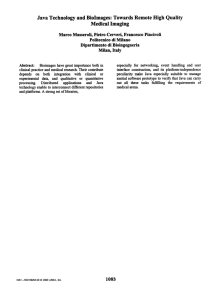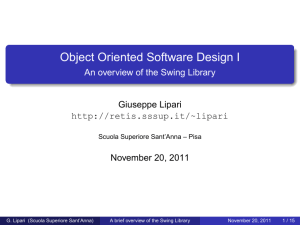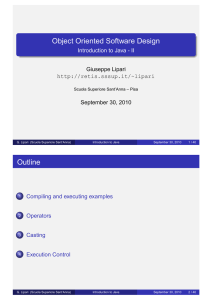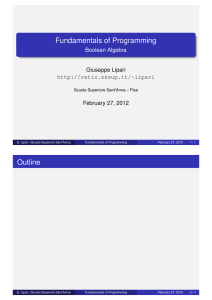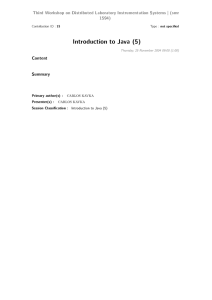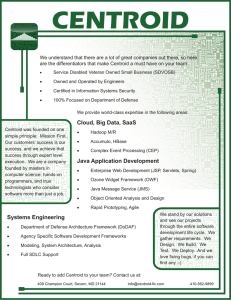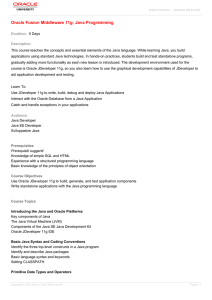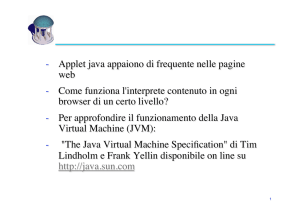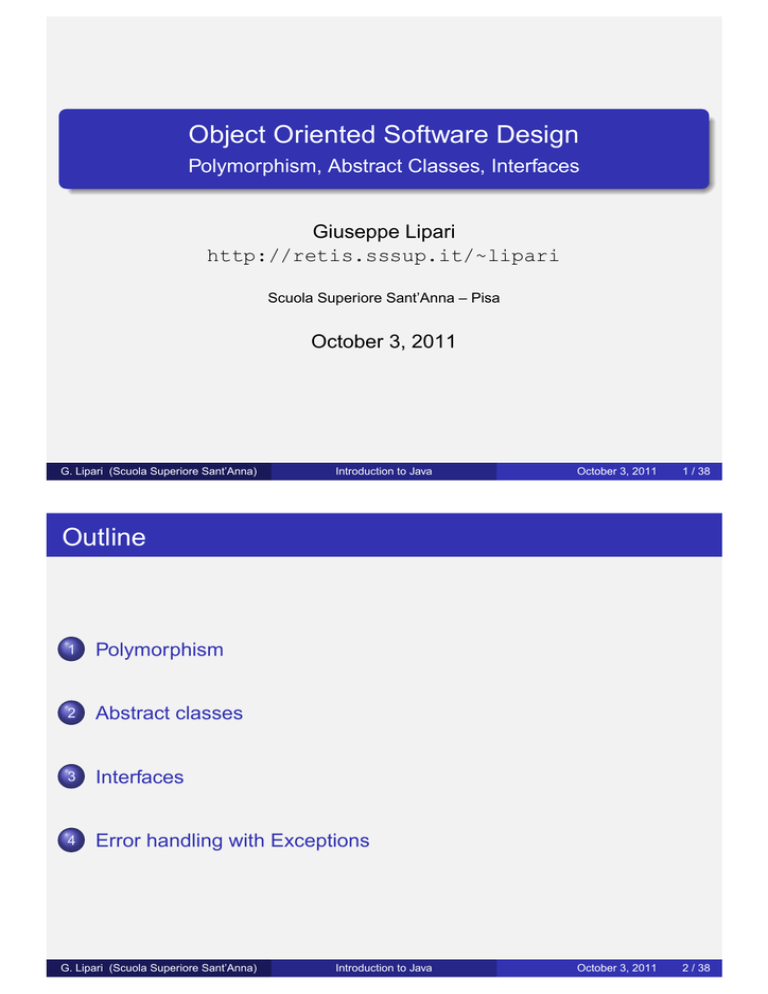
Object Oriented Software Design
Polymorphism, Abstract Classes, Interfaces
Giuseppe Lipari
http://retis.sssup.it/~lipari
Scuola Superiore Sant’Anna – Pisa
October 3, 2011
G. Lipari (Scuola Superiore Sant’Anna)
Introduction to Java
October 3, 2011
1 / 38
October 3, 2011
2 / 38
Outline
1
Polymorphism
2
Abstract classes
3
Interfaces
4
Error handling with Exceptions
G. Lipari (Scuola Superiore Sant’Anna)
Introduction to Java
Using Inheritance
Let’s complete the example with the instruments
Instrument
Note
void play(Note note)
Player
instrument
1
1
Player(Instrument instrument)
void tune(Instrument instrument)
void tuneAll(Instrument [] [music] instrument)
Wind
Stringed
void play(Note note)
Woodwind
void play(Note note)
void play(Note note)
Brass
void play(Note note)
G. Lipari (Scuola Superiore Sant’Anna)
Percussion
void play(Note note)
Violin
void play(Note note)
Introduction to Java
October 3, 2011
4 / 38
October 3, 2011
5 / 38
The Note class
Let’s start from the Note class
music/Note.java
package music;
public class Note {
private String noteName;
private Note(String noteName) {
this.noteName = noteName;
}
public String toString() { return noteName; }
public static final Note
C = new Note("C"),
C_SHARP = new Note("C Sharp"),
D
= new Note("D"),
D_SHARP
= new Note("D Sharp"),
E = new Note("E"),
F = new Note("F");
// Etc.
} ///:~
G. Lipari (Scuola Superiore Sant’Anna)
Introduction to Java
The Note class
The constructor is private
This means that the user of the class cannot create any object of
class Note
Also, there is only method toString() in the public interface
The only thing that we can do is to use the public static members
(C, D, E, etc.) that are all final (i.e. they are constant), and convert
them to String.
This the the standard way to create a set of constants with Java
Similar to the enum in C/C++
G. Lipari (Scuola Superiore Sant’Anna)
Introduction to Java
October 3, 2011
6 / 38
October 3, 2011
7 / 38
Class Instrument
Instrument is the base class of our hierarchy
music/Instrument.java
package music;
public class Instrument {
public void play(Note n) {
System.out.println("Instrument.play() " + n);
}
public String what() { return "Instrument"; }
public void adjust() {}
}
G. Lipari (Scuola Superiore Sant’Anna)
Introduction to Java
The Player class
music/Player.java
package music;
public class Player {
String name;
public Player(String name) {
this.name = name;
}
public String toString() {
return "Player : " + name;
}
public void tune(Instrument i) {
i.play(Note.C);
}
public void tuneAll(Instrument[] e) {
for(int i = 0; i < e.length; i++)
tune(e[i]);
}
}
G. Lipari (Scuola Superiore Sant’Anna)
Introduction to Java
October 3, 2011
8 / 38
October 3, 2011
9 / 38
The main
MusicPlayer.java
import com.bruceeckel.simpletest.*;
import music.*;
public class MusicPlayer {
public static void main(String[] args) {
Player player = new Player("Myself");
Instrument[] orchestra = {
new Wind(),
new Percussion(),
new Stringed(),
new Brass(),
new Woodwind()
};
player.tuneAll(orchestra);
G. Lipari (Scuola Superiore Sant’Anna)
Introduction to Java
What happens?
The Player does not know about the existence of any of the
Instrument classes
it calls the play() method of Instrument
and the play() method of the corresponding object is called
When the Player.java is compiled, how can the compiler know
which function to call?
This mechanism is called dynamic binding
At the time of compiling Player.java, the call is substituted by a
simple code that looks into a table to understand with method to call
We will see how the virtual table mechanism works when we will
study C++
Right now, just remember that in Java you only have dynamic
binding (and this causes some extra overhead in function calls)
G. Lipari (Scuola Superiore Sant’Anna)
Introduction to Java
October 3, 2011
10 / 38
Polymorphism
This mechanism is also called polymorphism, and Java methods
are said to be polymorphic
Now, let’s try to change the list of instruments
Also, let’s try to add a new Instrument (e.g. a Guitar)
Which code needs to be changed?
Not the Player class
Not the Instrument class
Only the MusicPlayer class which creates the Guitar object!
We added a new behaviour with minimal changes
The changes can even be less than that!
We are not always so lucky
Sometimes is not easy to minimise changes
For example, in some cases we must know the object type!
G. Lipari (Scuola Superiore Sant’Anna)
Introduction to Java
October 3, 2011
11 / 38
Classes you cannot instantiate
Let’s continue with the Instrument example
Does it make sense to create an object of a type Instrument?
Does it make sense to call the play() method of the base class
Instrument?
No, actually there is not such a thing as an Instrument
There are many types of Instrument
This is where Abstract classes are useful
We want to tell the language that it is not possible to create an
instrument, and call its method
Instrument represent an interface
You do so by saying that a method is abstract, i.e. it has not
implementation
You also have to say that the class is abstract
G. Lipari (Scuola Superiore Sant’Anna)
Introduction to Java
October 3, 2011
13 / 38
Abstract Instrument
Let’s see the abstract version of our Instrument class:
music2/Instrument.java
package music2;
public abstract class Instrument {
abstract public void play(Note n);
public String what() { return "Instrument"; }
public void adjust() {}
}
G. Lipari (Scuola Superiore Sant’Anna)
Introduction to Java
October 3, 2011
14 / 38
Abstract Wind
Of course, also Wind, Percussion and Stringed must be abstract:
music2/Wind.java
package music2;
public abstract class Wind extends Instrument {
abstract public void play(Note n);
public String what() { return "Wind"; }
public void adjust() {}
}
music2/Stringed.java
package music2;
public abstract class Stringed extends Instrument {
abstract public void play(Note n);
public String what() { return "Stringed"; }
public void adjust() {}
}
G. Lipari (Scuola Superiore Sant’Anna)
Introduction to Java
October 3, 2011
15 / 38
The main class
Notice that this time we cannot create Wind and Percussion
instruments:
MusicPlayer2.java
import com.bruceeckel.simpletest.*;
import music2.*;
public class MusicPlayer2 {
public static void main(String[] args) {
Player player = new Player("Myself");
Instrument[] orchestra = {
new Woodwind(),
new Violin(),
new Brass(),
new Woodwind()
};
player.tuneAll(orchestra);
G. Lipari (Scuola Superiore Sant’Anna)
Introduction to Java
October 3, 2011
16 / 38
Completely abstract classes
Instrument is now an abstract class
It contains normal methods (with code), and one abstract method
without code
Sometimes it is useful to have only interfaces, i.e. classes where
you do not provide any code at all
In Java this is done with the interface keyword
G. Lipari (Scuola Superiore Sant’Anna)
Introduction to Java
October 3, 2011
18 / 38
Instrument interface
Here is how Instrument is transformed into an interface:
music3/Instrument.java
package music3;
public interface Instrument {
int I = 5; // this is static and final
// all methods are public by default
void play(Note n);
String what();
void adjust();
}
G. Lipari (Scuola Superiore Sant’Anna)
Introduction to Java
October 3, 2011
19 / 38
How to use Instrument
With interfaces, you have to use the keyword implements instead
of extends
music3/Wind.java
package music3;
public abstract class Wind implements Instrument {
abstract public void play(Note n);
public String what() { return "Wind"; }
public void adjust() {}
}
music3/Stringed.java
package music3;
public abstract class Stringed implements Instrument {
abstract public void play(Note n);
public String what() { return "Stringed"; }
public void adjust() {}
}
G. Lipari (Scuola Superiore Sant’Anna)
Introduction to Java
October 3, 2011
20 / 38
The main class
Notice that you can declare a reference to an interface:
MusicPlayer3.java
import com.bruceeckel.simpletest.*;
import music3.*;
public class MusicPlayer3 {
public static void main(String[] args) {
Player player = new Player("Myself");
Instrument[] orchestra = {
new Woodwind(),
new Violin(),
new Brass(),
new Woodwind()
};
player.tuneAll(orchestra);
G. Lipari (Scuola Superiore Sant’Anna)
Introduction to Java
October 3, 2011
21 / 38
Multiple interfaces
A class can implement multiple interfaces
It makes sense, because sometimes an object can be seen as two
different types, depending on the context
However, a class can extend only one other class
The extend keyword must precede the implement keyword
The implementation of the interface methods need not to be in the
class itself
It can be in the base class, or in the derived classes (in the latter
case, the class becomes abstract)
G. Lipari (Scuola Superiore Sant’Anna)
Introduction to Java
October 3, 2011
22 / 38
October 3, 2011
23 / 38
Deriving from multiple interfaces
Adventure.java
interface CanFight {
void fight();
}
interface CanSwim {
void swim();
}
interface CanFly {
void fly();
}
class ActionCharacter {
public void fight() {}
}
class Hero extends ActionCharacter
implements CanFight, CanSwim, CanFly {
public void swim() {}
public void fly() {}
}
G. Lipari (Scuola Superiore Sant’Anna)
Introduction to Java
UML class diagram
CanFight
fight()
CanFly
CanSwim
fly()
swim()
ActionCharacter
fight()
Hero
fly()
swim()
G. Lipari (Scuola Superiore Sant’Anna)
Introduction to Java
October 3, 2011
24 / 38
Extending interfaces
It is possible to extend and combine interfaces to obtain more
complex ones
To extend an interface with additional methods, you can use
keyword extends, just as inheriting a derived class from a base
class
Unlike classes (where you can extend from one class only), you can
extend an interface from multiple base interfaces
public interface BInt1 {
void fun1();
int g();
}
interface BInt2 {
void fun2();
int h();
}
interface Der extends BInt1, BInt2 {
void fun3();
}
G. Lipari (Scuola Superiore Sant’Anna)
Introduction to Java
October 3, 2011
25 / 38
Exceptions
An exceptional condition is a run-time error that prevents the
continuation of the function or scope the program is currently
executing
A normal error is something you can deal with in the current scope
An exceptional condition is something you cannot do anything
about at the current point of the program
All you can do is to return from the method, signalling to the higher
levels that the method failed to complete
The typical way to handle this exceptional condition in C is to
return an error code
For example, many OS functions return a special error code to
mean that the function failed to complete successfully
Consider opening a file for reading. The user specifies the file
name, but what happens if a file with that name cannot be found
on the disk?
The open() function cannot do anything about it; it returns a special
error code, and the user has to check the return value to see if the
function was successful
G. Lipari (Scuola Superiore Sant’Anna)
Introduction to Java
October 3, 2011
27 / 38
Exceptions in object oriented
In procedural languages like C, handling exceptions is annoying
For each function, you have to check the return value, and write
some code to decide what to do
Sometimes, the error cannot be addressed directly, so we have to
propagate the error condition to the upper layers
This adds a substantial amount of effort for the programmer, and
makes the code less readable
In Object Oriented languages, the idea is that you can handle the
error where it is more appropriate through the concept of
Exceptions
An exception is just an object of a class (everything is an object)
that the programmer can throw to signal the error condition
The exception can then be caught where is more appropriate
G. Lipari (Scuola Superiore Sant’Anna)
Introduction to Java
October 3, 2011
28 / 38
Syntax
First, let’s use existing exceptions, provided by the Java library
MyClass t;
... // some code that works with t
if(t == null)
throw new NullPointerException();
In this example, we check if reference t points to an object
If not, we throw an exception of type NullPointerException()
Actually, the previous code is superfluous, since the same
exception is thrown automatically whenever you use a null
reference
G. Lipari (Scuola Superiore Sant’Anna)
Introduction to Java
October 3, 2011
29 / 38
Catching exceptions
To be able to catch an exception, you must enclose the code in a
try block
try {
// code that can throw an exception
} catch (Type1 exc1) {
// code to handle exceptions of Type1
} catch (Type2 exc2) {
// code to handle exceptions of Type2
} catch (Type3 exc3) {
// code to handle exceptions of Type3
}
When an exception is thrown,
The JVM looks for handler that catch the exception type
If it does not find them, it goes up one scoping level, again
searching for the right catch block
If it does not find it, the program is terminated with an error
An example:
./examples/06.java-examples/SimpleExceptionDemo.java
G. Lipari (Scuola Superiore Sant’Anna)
Introduction to Java
October 3, 2011
30 / 38
Constructors for Exceptions
Exceptions are objects, they can be made as complex as we need
FullConstructors.java
class MyException extends Exception {
public MyException() {}
public MyException(String msg) { super(msg); }
}
FullConstructors.java
public static void g() throws MyException {
System.out.println("Throwing MyException from g()");
throw new MyException("Originated in g()");
}
FullConstructors.java
try {
f();
} catch(MyException e) {
e.printStackTrace();
}
G. Lipari (Scuola Superiore Sant’Anna)
Introduction to Java
October 3, 2011
31 / 38
Throwable
Your exception must derive from an existing library class called
Exception, which extends class Throwable
One of the methods of Throwable is printStackTrace()
Here is the complete documentation for Exception
http://download.oracle.com/javase/1.6.0/docs/api/java/lang/Excepti
G. Lipari (Scuola Superiore Sant’Anna)
Introduction to Java
October 3, 2011
32 / 38
Exception specification
If your method can throw an exception, you must specify this in
the method declaration
You must use the keyword throws followed by a comma-separate
list of exceptions
If you do not specify anything, it means your method does not throw
anything
In Java you cannot lie: if you throw an exception, you have to
declare it in the method
The exception is part of the method signature
If a method of a base class specifies an exception list, all derived
classes that override that method must specify the same exception
list, else the compiler will complain
Java uses checked exceptions (i.e. the check is done at compile
time)
C++ is more liberal in this respect
G. Lipari (Scuola Superiore Sant’Anna)
Introduction to Java
October 3, 2011
33 / 38
Exceptions hierarchy
As you have already seen, exceptions can be organised into a
hierarchy of base-derived classes
When catching an exception, the normal type rules are applied
If you catch Exception, you are actually catching any type of
exceptions (as they all derive from class Exception).
try {
...
} catch (Exception e) {
// this catches any type of exception
}
The catch clauses are examined in the same order they are
written
It is convenient to put the above code at the end of the catch list, so
that you first try to catch more specific exceptions, and then more
generic ones.
G. Lipari (Scuola Superiore Sant’Anna)
Introduction to Java
October 3, 2011
34 / 38
Rethrowing an exception
Sometimes, when an exception is thrown, it is useful to catch it to
do some cleanup, and then throw it again so that the upper layers
can handle it
Therefore, inside a catch clause you can rethrow the same
exception you have just caught
catch(Exception e) {
System.err.println("An exception was thrown");
throw e;
}
You can also throw a different exception, of course (that is always
possible from anywhere)
G. Lipari (Scuola Superiore Sant’Anna)
Introduction to Java
October 3, 2011
35 / 38
Runtime exceptions
There is an entire hierarchy of special exceptions, whose base
class is RuntimeException
These exceptions are automatically thrown by the JVM
An example is NullPointerException
Another one is ArrayIndexOutOfBoundsException
It is not necessary to specify these exceptions in the exception
specification list of a method (since these ones can originate from
anywhere)
We say that these exceptions are unchecked, because the compiler
does not check from them
G. Lipari (Scuola Superiore Sant’Anna)
Introduction to Java
October 3, 2011
36 / 38
finally
After the catch clauses, you can insert a finally clauses, a block
of code that is always executed at the end
the finally clause is executed when the exception is thrown, and
when it is not thrown
try {
// The guarded region: Dangerous activities
// that might throw A, B, or C
} catch(A a1) {
// Handler for situation A
} catch(B b1) {
// Handler for situation B
} catch(C c1) {
// Handler for situation C
} finally {
// Activities that happen every time
}
An example:
./examples/06.java-examples/AlwaysFinally.java
G. Lipari (Scuola Superiore Sant’Anna)
Introduction to Java
October 3, 2011
37 / 38
Lost exceptions
Unfortunately exceptions can get lost
For example, when inside a finally clause, you call a method that
can throw another exception: the second one will overwrite the first
one.
./examples/06.java-examples/LostMessage.java
G. Lipari (Scuola Superiore Sant’Anna)
Introduction to Java
October 3, 2011
38 / 38

